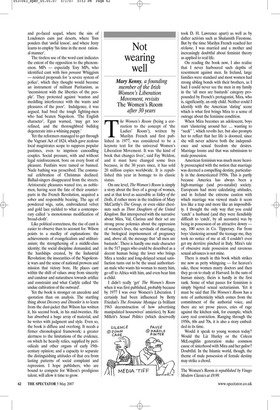Not wearing well
Mary Kenny, a founding member of the Irish Women’s Liberation Movement, revisits
The Women’s Room
after 30 years
The Women’s Room (being a correction to the concept of ‘the Ladies’ Room’), written by Marilyn French and first published in 1977, was considered to be a keynote text for the universal Women’s Liberation Movement. It was ‘the kind of book that changes lives’, said Fay Weldon, and it must have changed some lives because, in the 30 years since, it has sold 20 million copies worldwide. It is republished this year in homage to its classic status.
On one level, The Women’s Room is simply a story about the lives of a group of women, and at that level as accessible as Valley of the Dolls, if rather more in the tradition of Mary McCarthy’s The Group, or even older chestnuts such as Three Daughters of the United Kingdom. But interspersed with the narrative about Mira, Val, Clarissa and their set are strong prose polemics about the oppression of women’s lives, the servitude of marriage, the biological imprisonment of pregnancy and, above all, the message that ‘all men are bastards’. There is hardly one male character in the 517 pages who could be described as a decent human being: the lover who brings Mira a tender and long-delayed sexual satisfaction turns out to be the usual authoritarian male who wants his woman to marry him, go off to Africa with him, and even bear him a child.
I didn’t really ‘get’ The Women’s Room when it was first published, probably because by 1977 I was over Women’s Liberation. I certainly had been influenced by Betty Friedan’s The Feminine Mystique (a brilliant 1963 deconstruction of how advertising manipulated housewives’ anxieties), by Kate Millett’s Sexual Politics (which deservedly took D. H. Lawrence apart) as well as by dafter activists such as Shulamith Firestone. But by the time Marilyn French reached her réclame, I was married and a mother and increasingly doubtful about feminist theory as applied to real life.
On reading the book now, I also realise that I never harboured such depths of resentment against men. In Ireland, large families were standard and most women had strong sibling bonds with their brothers, as I had: I could never see the men in my family in the ‘all men are bastards’ category propounded by French’s protagonist, Mira, who is, significantly, an only child. Neither could I identify with the American ‘dating’ scene which is what first brings Mira to a sense of outrage about the feminine condition.
When Mira becomes an adolescent, boys start ‘clustering around her ... wanting to “neck” ’, which revolts her, but also prompts her to reflect that her life is doomed, since she will never achieve both the independence and sexual freedom she desires. Marriage looms and that was submission to male possession.
American feminism was much more heavily preoccupied with the notion that marriage was deemed a compelling destiny, particularly in the domesticated 1950s. This is partly because America has always been a high-marriage (and pro-natalist) society. Europeans had more calculating attitudes, and in Ireland the extreme caution with which marriage was viewed made it seem less like a trap and more like an impossibility. I thought the only way that you could ‘catch’ a husband (and they were fiendishly difficult to ‘catch’, by all accounts) was by being in possession of an attractive dowry say, 100 acres in Co. Tipperary. Far from boys ‘clustering around’ the teenage me, they took no notice of me at all. I couldn’t even get my derrière pinched in Italy. Mira’s tale of obsessive male possession and ravenous sexual advances is not mine.
There is much in this book which strikes me now as petty whingeing — for heaven’s sake, these women marry doctors and then they go on to study at Harvard. In the sum of human misery, theirs is hardly in the first rank. Some of what passes for feminism is simply bigoted sexual sectarianism. Yet it must be said that The Women’s Room has a note of authenticity which comes from the commitment of the authorial voice, and there are set prose pieces, cries of rage against the kitchen sink, for example, which carry real conviction. Ranging through the 1950s, 60s and 70s, it is also a story embedded in its time.
Would it speak to young women today? Would the Liz Hurley or the Coleen McLoughlin generation make common cause of sisterhood with Mira and her galère? Doubtful. In the Islamic world, though, the theme of male possession of female destiny may strike a chord.
The Women’s Room is republished by Virago Modern Classics at £9.99.


































































































 Previous page
Previous page